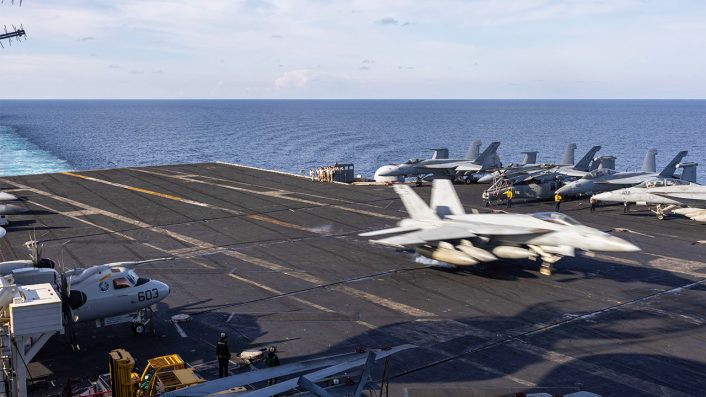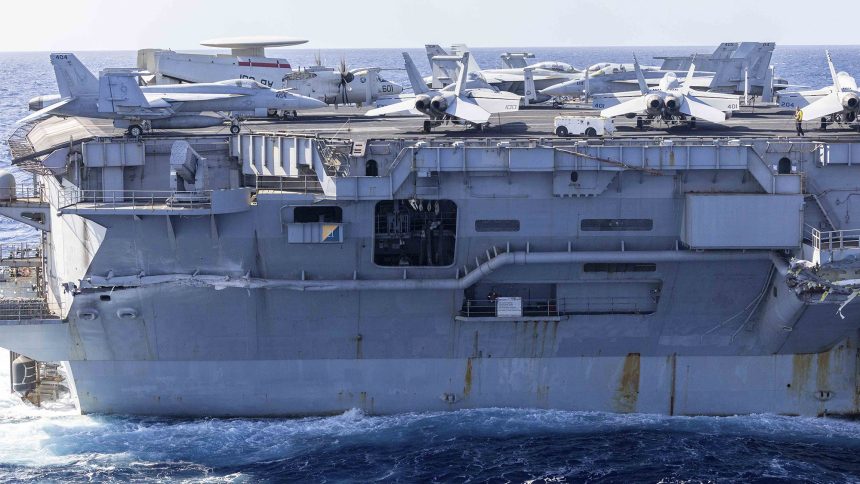Following its collision with merchant vessel Besiktas-M, the nuclear-powered aircraft carrier USS Harry S. Truman has sailed to Naval Support Activity Souda Bay, Crete, for repairs.
A U.S. Navy assessment revealed damage to two storage rooms on board the ship, alongside a maintenance space, line handling space, an exterior platform, and the fantail. According to Truman Commanding Officer Captain Dave Snowden the ship remained “fully mission capable” following the collision and continued flight operations were unimpeded.
Naval Support Activity (NSA) Souda Bay will host the ship as an Emergent Repair Availability (ERAV) is conducted on the ship’s damaged sections. While the damage is superficial enough to allow for continued operations if necessary, making repairs now when near a suitable port and while operations permit allows the crew to resume the use of non-critical but functional spaces which can provide much utility during a long deployment.

The USS Harry S. Truman (CVN 75), a Nimitz class nuclear powered aircraft carrier, began its current deployment in September 2024 and has ventured across Europe as well as into the Red Sea. It has been a fairly dramatic deployment, with the ship taking a leading role in Operation Prosperity Guardian against Houthi rebels in Yemen. Notably, during combat operations in December 2024 one of Truman’s F/A-18F Super Hornets was downed by U.S. Navy cruiser USS Gettysburg (CG 64) in a widely reported friendly fire incident.
Personnel from the Forward Deployed Regional Maintenance Center (FDRMC), headquartered alongside the U.S. 6th Fleet in Napes, Italy, will form an assessment team alongside staff from Norfolk Naval Shipyard, where all U.S. Navy aircraft carriers are constructed and overhauled. FDRMC will lead repairs from the pier with support from the ship’s company as well as local contractors.
A stop at Souda Bay, even without having suffered a collision, is a fairly common occurrence for U.S. Navy ships deployed to this region. It is one of the few locations outside of U.S. territory that sees regular dockings by U.S. Navy aircraft carriers, and is the only suitable port in the Mediterranean for ships of such a size.
The Truman, in fact, visited Souda Bay only days before the collision for a port visit allowing the ship’s company some time ashore. It is more unusual for a ship to visit the port again after such a short amount of time, but understandable given the repairs required.
USS Harry S. Truman (CVN 75) Nimitz-class aircraft carrier coming into Souda Bay, Crete – February 6, 2025 #ussharrystruman #cvn75
SRC: FB- Commander, 2nd Fleet pic.twitter.com/9ZPc4MuNrz
— WarshipCam (@WarshipCam) February 8, 2025
Rear Admiral Sean Bailey, who commands the overall Harry S. Truman carrier strike group (CSG) affirmed that “Harry S. Truman Carrier Strike Group (HSTCSG) units remain operational across geographic regions in support of their component commanders”. He further added: “Our mission has not changed and we remain committed to responding to any challenge in this dynamic and global security environment.”
As flagship of a CSG, the aircraft carrier usually hosts both its own commanding officer, holding the rank of captain, who is responsible for the aircraft carrier itself, as well as a flag officer, usually a rear admiral, who oversees the CSG in its entirety.
The Harry S. Truman CSG, numbered CSG 8, currently comprises the eight aircraft squadrons of Carrier Air Wing 1 (CVW 1), the Ticonderoga class guided missile cruiser USS Gettysburg (CG 64), and three Arleigh Burke class guided missile destroyers of Destroyer Squadron (DESRON) 28. These destroyers are the USS Stout (DDG 55), USS The Sullivans (DDG 68), and the USS Jason Dunham (DDG 109).
A Brief Respite
While it is never ideal for a major naval capability to require repairs in port, the Truman’s trip back to Souda Bay has come at a good time as far as operations are concerned. A ceasefire deal, though shaky, between Israel and Hamas has seen Houthi anti-shipping attacks paused for at least the time being. With no attacks to defend from, nor retaliate for, the lack of a Carrier Strike Group operating in or near the Red Sea will have less impact than it would have had several months earlier.
The situation in the region remains volatile, and it is possible attacks might resume at any point. This may be a reason playing into the decision to send the Truman on its rapid trip for repairs, as military planners may fear the ship and the strike group could be held in the region at a high operational tempo for many months to come. If anything has been proven by the last two years, it is that the operational picture of the Middle East region can be turned on its head overnight.
As of Feb. 1, 2025, the operational command for Operation Prosperity Guardian shifted from Combined Task Force (CTF) 153 to Destroyer Squadron (DESRON) 50, headquartered in Bahrain. Meanwhile, the European Union coordinated naval effort to protect merchant ships, named Operation Aspides, has been extended until February 2026. European Union Naval Force (EUNAVFOR) assigned ships from various nations continue to operate in the Red Sea and the surrounding area.
ITS MARTINENGO 🇮🇹 completed a successful close protection mission to merchant vessels in the area of operation, under EUNAVFOR ASPIDES.
EUNAVFOR ASPIDES has a totally defensive mandate, contributes to regional stability and prosperity by protecting global common goods. pic.twitter.com/equVvL1nA6
— EUNAVFOR ASPIDES (@EUNAVFORASPIDES) January 31, 2025
While not capable of the same level of retaliatory or preventative strikes as the Carrier Strike Group, the remaining forces allow for the continued protection of civilian vessels.
The U.S. Navy recently revealed that their contribution to defending ships from Houthi attacks used ammunition to the value of over $1 billion. This included 220 missiles as well as around 160 rounds from 5 in naval guns. A running theme across the entire operation has been the need for ships to leave the operation regularly to re-arm at friendly ports, as reloading vertical launch system (VLS) missiles at sea is still not a capability that is widely deployed.
Notably, though, reports indicate that a number of attacks were thwarted by non-kinetic means. While the specific capability used is not identified, this is likely to be an electronic warfare capability that can disrupt or jam drones and missiles, downing them without requiring any ammunition. As inexpensive attack drones become more and more prevalent, these non-kinetic capabilities as well as laser-based defense systems that do not require reloads, will become more and more important.









